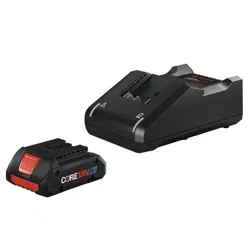Loading ...
Loading ...
Loading ...

4
of fire and electrical shock. If an extension
cord is used, make sure:
a. The pins on plug of extension cord are
the same number, size, and shape as
those of plug on charger.
b. The extension cord is properly wired
and in good electrical condition.
c. The wire size is large enough for AC
ampere rating of charger as specified
below:
d. An extension cord is a temporary
solution. Move the charger to a
standard receptacle as soon as the job
has been completed.
▶ Important Charging Notes
1. The charger was designed to fast
charge the battery only when the
battery temperature is between 32˚F
(0˚C) and 113˚F (45˚C). If the battery
pack is too hot or too cold, the
charger will not begin charging the
battery. (This may happen if the
battery pack is hot from heavy use).
Once the battery temperature returns
to its safe charging temperature,
between 32°F (0°C) and 113°F
(45°C), the charger will automatically
begin charging.
2. A substantial drop in operating time
per charge may mean that the battery
pack is nearing the end of its life and
should be replaced.
3. Remember to unplug charger during
storage period.
4. If battery does not charge properly:
a. Check for voltage at outlet by
plugging in some other electrical
device.
b. Check to see if outlet is connected
to a light switch which turns power
“off” when lights are turned off.
c. Check battery pack terminals and
charger connectors for dirt. Clean
with cotton swab and alcohol if
n
ecessary.
d. If you still do not get proper
charging, take or send tool, battery
p
ack and charger to your local Bosch
Service Center. See “Tools, Electric”
in the Yellow Pages for names and
addresses.
Note: Use of chargers or battery packs not
sold by Bosch will void the warranty.
▶ FCC Caution:
The manufacturer is not responsible for
radio interference caused by unauthorized
modifications to this equipment. Such
modifications could void the user’s
authority to operate the equipment.
This device complies with Part 15 of the
FCC Rules. Operation is subject to the
following two conditions:
1) This device may not cause harmful
interference, and
2) This device must accept any
interference received, including
interference that may cause undesired
operation.
NOTE! This equipment has been tested and
found to comply with the limits for a Class
B digital devices, pursuant to Part 15 of the
FCC rules. These limits are designed to
provide reasonable protection against
harmful interference in a residential
installation. This equipment generates uses
and can radiate radio frequency energy
and, if not installed and used in accordance
with the instructions, may cause harmful
interference to radio communications.
However, there is no guarantee that
interference will not occur in a particular
installation. If this equipment does cause
harmful interference to radio or television
reception, which can be determined by
turning the equipment off and on, the user
is encouraged to try to correct the
interference by one or more of the
following measures:
• Reorient or relocate the receiving
antenna.
• Increase the separation between the
equipment and receiver.
• Connect the equipment into an outlet
on a circuit different from that to
which the receiver is connected.
Length of
Cord, Feet
25 50 100 150
AWG Size
of Cord
18 16 16 14
2610051857.qxp_GAL18V-40 1/8/19 10:50 AM Page 4
Loading ...
Loading ...
Loading ...
